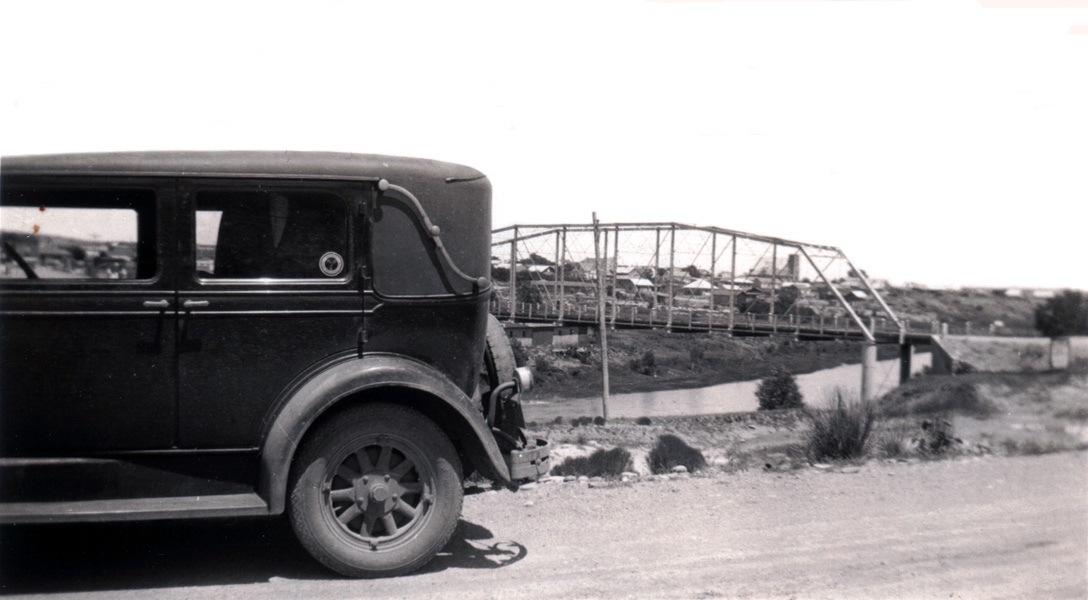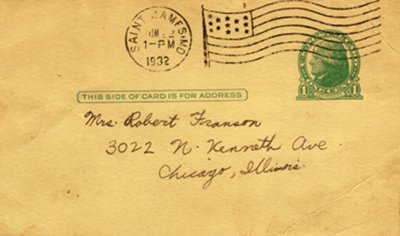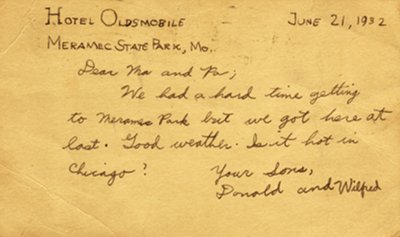Old Route 66
1932, 1934, 1946
The old roads of History
If you, your parents, or your grandparents came West to Southern California from anywhere in the Middle West, there is a good chance that you remember or have heard about the good old highway US 66.
I drove Route 66 from end to end three times in the 1930s and once in the 1940s. To get some idea of how long ago that was, look at it this way. From Abraham Lincoln's time to my "explorations" in the 1930s, the clock of time counted off about seventy years. From the 1930s to the early 2000s, about seventy years have passed. Hard to understand, but apparently I have lived half as long as history. There may be something wrong with my math, but Route 66 has been there a long time.
Route 66 has become a symbol of the old roads, and our memories of the road will differ according to the period when we rolled along it. Parts of the original highway exist, and many dedicated people have been working hard to preserve and restore the buildings, signs, and other artifacts along the old road.

1932: cowboys; desert; "Hotel Oldsmobile"
In 1932 my brother and I (15 and 20 years old) packed some clothes into my well-worn 1928 Oldsmobile four-door sedan in Chicago, and took off toward the Southwest, a region we had heard about but had never seen.
Our minds were loaded with images of the Southwest from magazines, books, movies, and radio shows. We knew we would see oil wells, cattle, cowboys, deserts, canyons, long rows of palm trees, and orange groves. We did see all that, and more. We talked with real cowboys, changed tires in desolate places, got lost a few times when we tried interesting side roads, and had a fine time.
We slept in the car most nights; about one night in three or four we spent a few bucks on a motel or one of those places that advertised "Rooms For Tourists". I slept in the front seat and my brother Donald slept in the back seat. Our joints were more flexible then, and it wasn't so bad. We sent home postcards from our "Hotel Oldsmobile". We saw many families sleeping along the sides of the road.
We spent some time at the Petrified Forest and Grand Canyon. While misreading my map, I took a wrong turn near Flagstaff and we wandered for most of a day, totally lost, driving through ranches, opening and closing gates, until we finally found the right road.
After seeing the Grand Canyon we got back on Route 66 and followed it to its end. We had seven flat tires on the gravel sections of US 66, but had no more tire trouble after we reached the Western end of US 66 in Santa Monica and turned North toward other sights up the coast.
1934: dust; waiting for the stage; Indians
My second trip on Route 66 was in 1934, in the same 1928 Oldsmobile. Western drought and dust storms were in the news, and the massive migration westward had accelerated. John Steinbeck's stories in The Grapes of Wrath about the road and the roadside people (about five years later) were absolutely accurate.
On that trip I took US 66 both ways. I had new tires, so I had only one flat tire. Driving too fast near Victorville, California, I pounded out a connecting rod bearing and had to wait in a garage for the replacement bearing to come from San Bernardino. The mechanic said the part would come by stage and might be there that afternoon. When I head the word "stage" I immediately had a mental picture of a Wells Fargo stagecoach, drawn by husky, sweating horses, and controlled by a tough driver, accompanied by another tough Westerner riding shotgun to protect the cases of California gold they were taking to the bank. But, sadly, when the "stage" came, it was an ordinary bus.
Other things have changed, too. Freeways serve a purpose but they have changed the way we drive on cross-country trips. I remember the Indians who sold souvenirs at the sides of Route 66 in New Mexico and Arizona. Interstate highways wiped that out, and we have lost the roadside culture (some may call it "clutter"). The Ma and Pa gas stations and small restaurants are just about gone. Fortunately, some of the side roads still exist.
My third trip on Route 66 was in 1946. After my discharge from the Army Air Force at Charleston, South Carolina, my wife Vera and I took off in a 1936 Buick four-door sedan to visit our families, which meant a zigzag trip to West Virginia, Milwaukee, Chicago, and then a long drive the full length of Route 66 to Los Angeles, where my parents had moved from Chicago.
The roads had been improved since my brother and I drove it in 1932. Also, we had good luck with the Buick and only a few minor problems on the trip: a case of vapor lock on a side trip to Nevada, and some front suspension parts replaced in Los Angeles. This trip ended in Eugene, Oregon, where I had lived for a while before World War II. I still have the Buick's steering wheel, which I salvaged when I sold the faithful old car to a farmer who said he would make it into a trailer.
© 1999, 2001 Wilfred R. Franson
Map & History of U.S. Route 66,
the Will Rogers Highway
Day-Nite Garage, The
Eugene, Oregon 1939-1941
photo, above:
"Hotel Oldsmobile"
by WRF / DLF
More by Wilfred R. Franson
Transport at Troynovant
ships, trains, autos,
aircraft, spacecraft
| Troynovant, or Renewing Troy: | New | Contents | |||
| recurrent inspiration | Recent Updates | |||
|
www.Troynovant.com |
||||
|
Essays:
A-B
C-F
G-L
M-R
S-Z
|
||||
| Personae | Strata | Topography | |
|
|||

